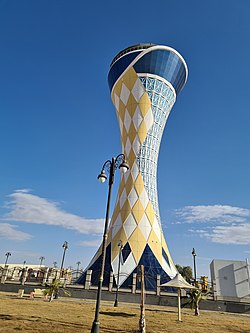Top Qs
Timeline
Chat
Perspective
Northern Borders Province
Administrative region of Saudi Arabia From Wikipedia, the free encyclopedia
Remove ads
The Northern Borders Province, also known as the Northern Borders Region (Arabic: منطقة الحدود الشمالية Al-Ḥudūd Aš-Šamāliyya) is a province in Saudi Arabia, situated in the northern region, bordering Iraq to the north and northwest, and Jordan to the west.[1]
Remove ads
History
Historically, the province served as a key passage for caravans and trade between the Arabian Peninsula, the Levant, and Mesopotamia. It was established as an official administrative province in 1970, and its proximity to international borders has given it strategic importance since the formation of the Sultanate of Nejd in the early 20th century. In recent decades, the province has witnessed growing development in infrastructure and industry, particularly in mining, as part of national efforts to stimulate growth in northern Saudi Arabia.[2]
Remove ads
Geography
Summarize
Perspective
The Northern Borders Province is located in the far north of Saudi Arabia. It shares international borders with Jordan to the northwest and Iraq to the north. Domestically, it borders the Eastern Province to the south, Al-Jawf Province to the west, Hail Province and Al-Qassim Province to the southwest. The province covers an area of approximately 104,000 square kilometers, making up about 5.3% of the total area of Saudi Arabia.[2]
The province experiences a continental desert climate, with hot summers and cold winters—temperatures can drop below freezing in winter, and occasional snowfall is observed on elevated terrain. Rainfall is sparse and mainly occurs during the winter and spring seasons.[3]
Geologically, the province lies on the Arabian Shelf, and is known for its rich mineral deposits, particularly phosphate. It hosts the Waad Al-Shamal Industrial City, a major mining and industrial hub established to support Saudi Arabia’s economic diversification, with investments exceeding SAR 85 billion.[2]
The Northern Borders Province also includes several protected natural reserves, such as Mu'ayla, Al-Owaisi, Al-Ghurabah, and a portion of the Harrat Al-Harrah reserve. These areas are home to desert wildlife and are associated with traditional hunting practices like falconry.[2]
Remove ads
Etymology
The name Al-Ḥudūd Aš-Šamāliyya (Arabic: الحدود الشمالية) translates literally to "the Northern Borders" in English. It is derived from two Arabic words: al-ḥudūd (الحدود), meaning "the borders" or "boundaries," and aš-šamāliyya (الشمالية), meaning "northern." The name reflects the province's geographical position in the far north of Saudi Arabia, where it borders Iraq and Jordan. The term emphasizes the region's role as a frontier zone and its historical significance as a point of connection and transition between the Arabian Peninsula and the Levant.
Transportation
The Northern Borders Province is served by several domestic airports that connect its main cities to other parts of Saudi Arabia:
- Arar Domestic Airport – serving the capital city of Arar.
- Rafha Domestic Airport – serving the city of Rafha.
- Turaif Domestic Airport – serving the northern city of Turaif.
In addition to air travel, the region is connected to neighboring Iraq through the Jadidat Arar border crossing. This port of entry was officially closed in 1990 following the Gulf War, except during the Hajj season. It was partially reopened in 2017 for limited travel and religious purposes, and later fully reopened on November 18, 2020[4] for travelers, visitors, and commercial transport between Saudi Arabia and Iraq.
The province is also linked by major highways, including:
Remove ads
Education
Summarize
Perspective
The Northern Borders Province is served by Northern Borders University (NBU), the only university in the province. It was established in 2007 by royal decree following a visit by the late King Abdullah. The university's main campus is located in Arar, with additional branches in Rafha, Turaif, and Al-Uwayqilah. It offers a variety of academic programs across disciplines such as medicine, engineering, computer science, business, and education. The university serves both men and women.
The province also has a network of public schools administered by the Ministry of Education, serving students at the elementary, intermediate, and secondary levels. Schools are distributed across urban centers and smaller towns to ensure access to education for all residents.[5]
In addition to the university, the province hosts several institutions for technical and vocational education and training. These institutions are managed by the Technical and Vocational Training Corporation (TVTC),[6] and include the following and more:
- Technical College in Rafha
- Technical College in Arar
- Technical College in Turaif
- Technical College for Girls in Arar
There are also secondary industrial institutes that provide vocational training at the high school level:
- Secondary Industrial Institute in Turaif
- Secondary Industrial Institute in Rafha
Remove ads
Governorates
List of governors
See also
References
Wikiwand - on
Seamless Wikipedia browsing. On steroids.
Remove ads


